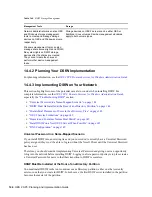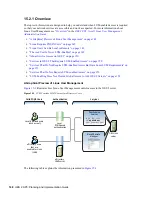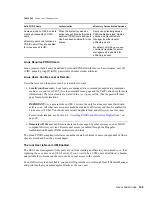
144
OES 2 SP3: Planning and Implementation Guide
Table 14-3
DSfW Storage Management
14.4.2 Planning Your DSfW Implementation
For planning information, see the
OES 2 SP3: Domain Services for Windows Administration Guide
.
14.4.3 Implementing DSfW on Your Network
This section highlights some of the potential caveats to consider when installing DSfW. For
complete information, see the
OES 2 SP3: Domain Services for Windows Administration Guide
,
especially the “
Troubleshooting DSfW
” section.
“Universal Password in a Name-Mapped Scenario” on page 144
“DSfW Must Be Installed at the Root of an eDirectory Partition” on page 144
“Hierarchical Placement of Users in the eDirectory Tree” on page 145
“OES 2 Service Limitations” on page 145
“Domain and Container Names Must Match” on page 145
“Install DSfW on a New OES 2 Server When Possible” on page 145
“DNS Configuration” on page 145
Universal Password in a Name-Mapped Scenario
If you install DSfW into an existing tree and your users don’t currently have a Universal Password
policy assigned, they won’t be able to log in without the Novell Client until the Universal Password
has been set.
Therefore, you should consider implementing Universal Password and giving users an opportunity
to log into the network before installing DSfW. Logging in after a password policy is in place creates
a Universal Password for users so that their transition to DSfW is seamless.
DSfW Must Be Installed at the Root of an eDirectory Partition
You must install DSfW in the root container or an eDirectory partition, either one that currently
exists or one that you create for DSfW. In both cases, the first DSfW server installed in the partition
becomes the master of the partition.
Management Tools
Storage
Network administrators use native OES
and Windows storage management
tools to create and manage storage
devices on OES and Windows servers,
respectively.
Windows management tools can also
manage share access rights and POSIX
file system rights on DSfW storage
devices after the shares are created.
They cannot create the shares or
perform other device management
tasks.
Storage devices on OES 2 servers can be either NSS or
traditional Linux volumes. Samba management standards
apply to both volume types.
Содержание OPEN ENTERPRISE SERVER - CONVERSION GUIDE 12-2010
Страница 12: ...12 OES 2 SP3 Planning and Implementation Guide...
Страница 24: ...24 OES 2 SP3 Planning and Implementation Guide...
Страница 50: ...50 OES 2 SP3 Planning and Implementation Guide...
Страница 74: ...74 OES 2 SP3 Planning and Implementation Guide...
Страница 78: ...78 OES 2 SP3 Planning and Implementation Guide...
Страница 80: ...80 OES 2 SP3 Planning and Implementation Guide...
Страница 96: ...96 OES 2 SP3 Planning and Implementation Guide...
Страница 146: ...146 OES 2 SP3 Planning and Implementation Guide...
Страница 176: ...176 OES 2 SP3 Planning and Implementation Guide...
Страница 210: ...210 OES 2 SP3 Planning and Implementation Guide...
Страница 218: ...218 OES 2 SP3 Planning and Implementation Guide...
Страница 226: ...226 OES 2 SP3 Planning and Implementation Guide...
Страница 234: ...234 OES 2 SP3 Planning and Implementation Guide...
Страница 236: ...236 OES 2 SP3 Planning and Implementation Guide...
Страница 244: ...244 OES 2 SP3 Planning and Implementation Guide...
Страница 246: ...246 OES 2 SP3 Planning and Implementation Guide...
Страница 250: ...250 OES 2 SP3 Planning and Implementation Guide...
Страница 254: ...254 OES 2 SP3 Planning and Implementation Guide...
Страница 258: ...258 OES 2 SP3 Planning and Implementation Guide...
Страница 284: ...284 OES 2 SP3 Planning and Implementation Guide...
Страница 286: ...286 OES 2 SP3 Planning and Implementation Guide...
Страница 294: ...294 OES 2 SP3 Planning and Implementation Guide...
















































